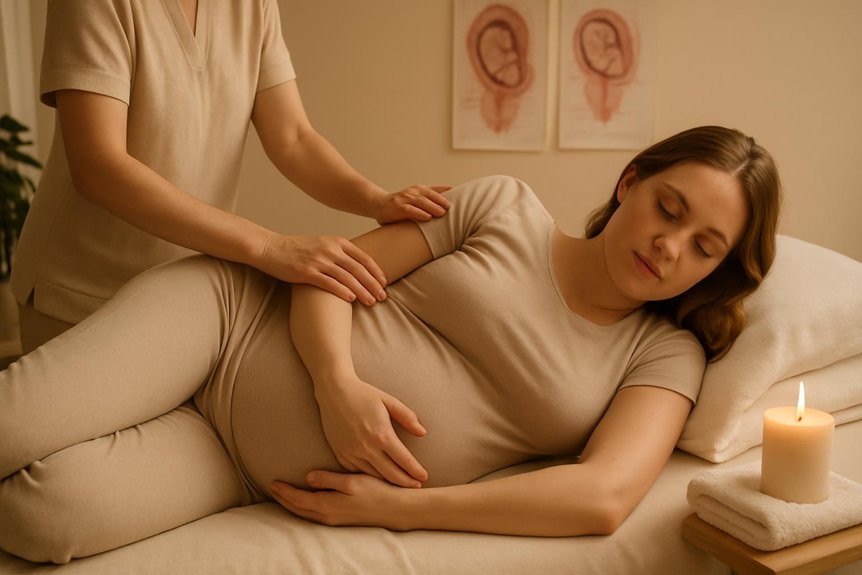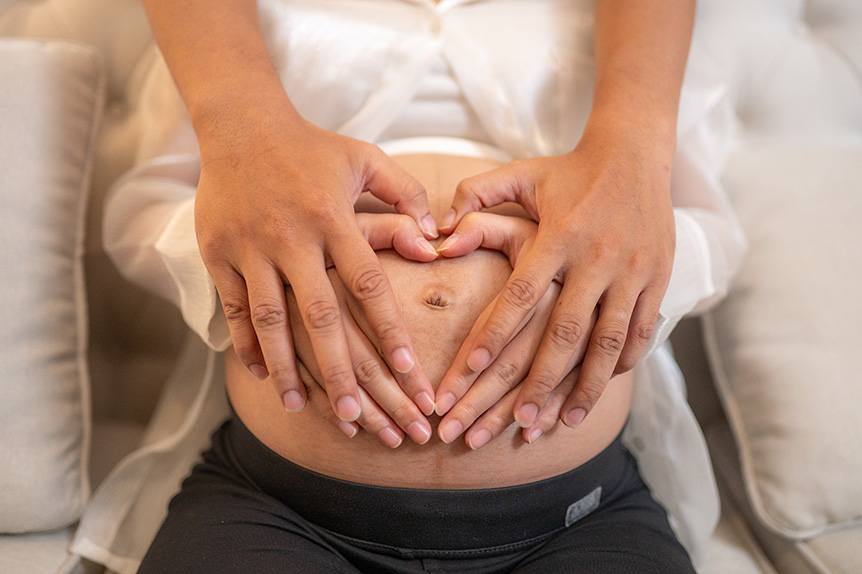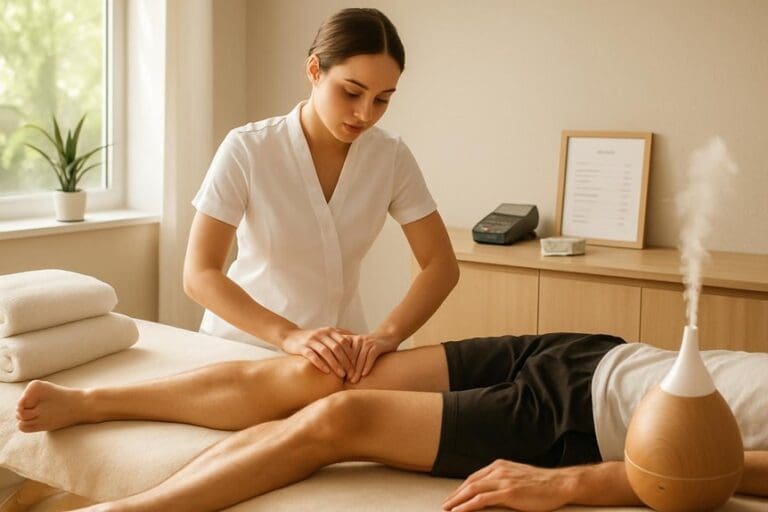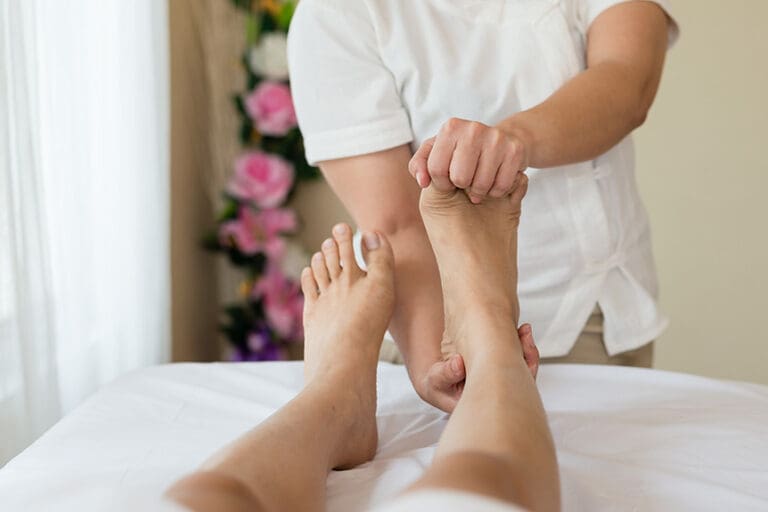Most first‑trimester miscarriages arise from chromosomal or implantation issues, not external factors. Evidence does not show that routine, gentle prenatal massage causes miscarriage when performed by a trained therapist. Safe care uses light‑to‑moderate pressure, avoids deep work on the abdomen, uterus, sacrum, and certain acupressure points, and modifies positioning. Postpone massage for bleeding, cramping, severe pain, fever, or concerning symptoms, and seek medical advice. Aromatherapy at typical spa dilutions is generally safe with brief exposure. More practical guidance follows.
Understanding Miscarriage Risk in the First Trimester

Why is miscarriage most common in the first trimester? Most losses occur before 12 weeks because early embryonic development is highly vulnerable to chromosomal abnormalities, which account for the majority of spontaneous miscarriages.
Hormonal insufficiency, implantation issues, uterine anomalies, and uncontrolled conditions such as thyroid disease, diabetes, or antiphospholipid syndrome also contribute.
Age increases baseline risk, particularly over 35.
Typical signs include vaginal bleeding and cramping; however, light spotting can be benign.
Emergency care is warranted with heavy bleeding, severe pain, fever, or fainting.
Spa & Massage recognises that early pregnancy is emotionally tender. Their clinicians advise gentle, non-invasive wellbeing choices, emphasising rest, hydration, and medical follow-up when concerns arise.
Clients are encouraged to share pregnancy status so care can be adapted thoughtfully and safely.
Some modalities such as aromatherapy massage are designed to promote relaxation, but extra caution is needed during pregnancy to ensure both safety and comfort.
What the Evidence Says About Massage and Miscarriage
Current evidence does not show that properly conducted massage increases miscarriage risk, though early pregnancy remains a vulnerable period requiring clinical caution.
Safe approaches emphasize light-to-moderate pressure, side-lying positioning, avoidance of abdominal/deep pelvic work, and therapist training in pregnancy-specific contraindications—principles followed by Spa & Massage therapists.
Timing considerations include deferring treatment during active bleeding, severe nausea, fever, or unexplained pain, and seeking obstetric guidance for high-risk pregnancies before booking.
Research on Miscarriage Risk
Decades of obstetric and massage research indicate that routine, gentle massage is not associated with an increased risk of miscarriage in uncomplicated pregnancies. Large cohort and case–control studies attribute most first‑trimester losses to chromosomal anomalies, not external mechanical factors. Trials of prenatal massage show improvements in anxiety, pain, and sleep without higher miscarriage rates.
Meta-analytic reviews likewise report no causal link between light-to-moderate pressure bodywork and early pregnancy loss.
Evidence does not implicate aromatherapy at typical spa dilutions when non-restricted oils are used and exposure is brief. Observational data suggest that perceived “triggering” often reflects timing, not causation.
In practice, Spa & Massage aligns with this evidence base: therapists deliver gentle, tailored sessions, screen for red flags, and coordinate with clients’ midwives or GPs when needed.
Safe Techniques in Pregnancy
Building on findings that routine, gentle massage does not raise miscarriage risk in uncomplicated pregnancies, attention turns to what constitutes safe technique. Evidence supports light-to-moderate pressure, slow strokes, and attentive pacing, avoiding abdominal compression and vigorous work over the inner thighs.
Positioning matters: side-lying with cushion support reduces aortocaval pressure and keeps breathing easy. In Spa & Massage clinics, therapists use neutrally scented, hypoallergenic oils, check skin sensitivity, and maintain warm, steady contact to calm the nervous system.
Practitioners avoid deep trigger-point work to pelvis, sacrum, and medial calves; they use broad, nurturing effleurage over back, shoulders, hips, hands, and feet while steering clear of forceful acupressure. Communication guides every session—clients set comfort thresholds, therapists adjust pressure, temperature, and duration, preserving safety and tenderness.
Timing and Contraindications
A careful look at timing shows no evidence that routine, gentle massage increases miscarriage risk in an uncomplicated pregnancy, including the first trimester. Most professional bodies permit light-to-moderate, non-abdominal work throughout pregnancy when performed by trained therapists.
Timing is still purposeful: shorter sessions in weeks 6–12 can reduce fatigue and nausea; side-lying positioning supports comfort as the uterus enlarges.
Contraindications are clear: avoid massage with vaginal bleeding, severe abdominal pain, fever, suspected preeclampsia, uncontrolled vomiting, unexplained calf pain/swelling (possible DVT), or after recent procedures until cleared.
Local avoidance applies to open wounds, rashes, or acute injuries. At Spa & Massage, therapists screen carefully, coordinate with maternity care, and use unscented or mild aromatherapy by request.
Any red-flag symptom prompts deferral and referral.
Safe Massage Timing and Trimester-Specific Considerations

While timing and technique matter throughout pregnancy, evidence and clinical consensus support tailored approaches by trimester to optimise safety and comfort.
In the first trimester, light, calming sessions may proceed when there are no red-flag symptoms; prioritising rest, gentle touch, and avoiding abdominal pressure reduces nausea and sensory overload.
In the second trimester, side-lying positioning with appropriate bolster support becomes standard to protect circulation and the uterus; session length can widen as energy returns.
From 28 weeks, left side-lying, frequent position changes, and vigilant monitoring for dizziness or shortness of breath are advised; avoiding supine pressure mitigates vena cava compression.
At Spa & Massage in London, therapists schedule sessions around obstetric guidance, adapt positioning and pacing, and coordinate with clients’ midwives when needed to maintain serene, safe care.
Techniques and Pressure Levels Our Therapists Use for Pregnancy
Spa & Massage outlines clear protocols for pregnancy care: light-to-moderate pressure over safe zones (back, shoulders, limbs) while avoiding deep pressure on the abdomen and cautioning around ankles and sacrum.
Techniques are adjusted by trimester—gentle, circulation-focused work early on, progressing to targeted myofascial and edema-management strategies later—always within comfort thresholds and with informed consent.
Positioning is optimized using side-lying or semi-reclined setups with bolsters to maintain uteroplacental blood flow, reduce vena cava compression, and support joint stability.
Safe Pressure Zones
In early pregnancy, safe-pressure massage focuses on moderate, well-distributed touch that respects maternal physiological changes and avoids trigger points linked to uterine stimulation.
At Spa & Massage clinics across London, therapists prioritise zones with strong safety profiles: upper back, shoulders, arms, hands, calves, feet (avoiding deep pressure on the inner/medial arch), neck, scalp, and face.
The lower back and lateral hips receive gentle, broad strokes only, steering clear of sacral compressions and deep gluteal work.
Abdominal massage is omitted in the first trimester.
Pressure remains within a 3–4/10 scale, continuously adjusted to client feedback, breathing, and tissue response.
Therapists avoid acupressure points associated with pelvic activity (e.g., SP6, LI4, BL60).
Neutral, hypoallergenic oils are used, with meticulous positioning and bolstering for circulatory ease.
Trimester-Specific Techniques
Because maternal physiology evolves rapidly across pregnancy, techniques and pressure are adjusted by trimester to optimise safety and therapeutic effect.
In the first trimester, Spa & Massage therapists prioritise gentle, rhythmic effleurage, breath-led pacing, and light-to-moderate pressure to ease nausea-related tension and fatigue without provoking vasodilation or overheating.
Targeted deep pressure is avoided, especially over the abdomen, pelvis, and known acupressure induction points.
During the second trimester, with stabilised circulation and posture changes emerging, moderate pressure to paraspinals, gluteals, and hips is introduced, using slow myofascial strokes to reduce sacroiliac load and calf tightness.
Precise lymphatic sweeping supports fluid balance.
Positioning and Support
Positioning and support anchor safe, effective pregnancy massage, complementing trimester-specific pressure choices. At Spa & Massage, therapists prioritise left side-lying or semi-reclined positions to optimise uteroplacental blood flow and maternal comfort.
Bolsters and memory-foam wedges stabilise the pelvis, unload the lumbar spine, and relieve rib-cage pressure. Prone positioning is avoided once breast or abdominal tenderness appears; supine time is kept brief and inclined to reduce vena cava compression.
Pressure is moderate, slow, and purposefully superficial over the abdomen, sacrum, and medial calves; deeper work targets shoulders, gluteals, and lateral hips only when tissue response is relaxed and client feedback is easy.
Gentle myofascial glides, sustained holds, and lymphatic strokes manage swelling without provoking guard. Therapists cue diaphragmatic breathing, adjust supports with each trimester, and stop immediately if dizziness, nausea, or pelvic pain occurs.
Areas to Avoid and When to Modify a Session

Although most touch is safe in early pregnancy, certain regions and techniques warrant caution and clear modification.
Evidence supports gentle, circulation‑supportive work while avoiding deep, sustained pressure over the abdomen, uterine area, and sacrum; vigorous compression to the inner thighs; and acupressure at historically stimulatory points (e.g., SP6, LI4).
Broad, light strokes to the lower back and hips can soothe, but therapists should not use percussive or high‑heat methods.
At Spa & Massage, clinicians adjust intensity when clients report cramping, spotting, nausea, dizziness, or fatigue, and they pause treatment if symptoms escalate.
They also modify sessions for IVF, prior miscarriage, placenta‑related concerns, hypertension, bleeding disorders, fever, or new pelvic pain.
Clear consent, slower pacing, and responsive, listening hands ensure comfort while prioritising maternal and fetal safety.
Oils, Positioning, and Comfort Measures We Recommend
With safety parameters in mind, the next priorities are skin-compatible oils, stable positioning, and simple comfort measures that reduce strain and nausea.
At Spa & Massage, therapists use neutral, hypoallergenic bases such as fractionated coconut or grapeseed, fragrance-free unless a client requests a mild, pregnancy-appropriate scent after patch testing. Essential oils, if used, are kept at low dilution and exclude known irritants.
Positioning emphasises left lateral or semi-reclined support with bolsters at the knees, ankles, and behind the back to maintain uteroplacental blood flow and ease lumbar load. Abdominal pressure is avoided; strokes remain light-to-moderate and rhythmic.
Comfort measures include slow progressions, room temperature control, anti-nausea cues (mint water, pauses for breath), and clear consent checks.
Our approach prioritises warmth, privacy, and unhurried touch that nurtures without overstimulating.
Signs to Pause or Postpone Massage and When to Seek Medical Advice
Should new or worsening symptoms arise, a prenatal massage should be paused and clinical assessment considered.
Concerning signs include vaginal bleeding or fluid leakage, persistent or escalating abdominal pain, cramping with back pressure, dizziness or faintness, chest pain, shortness of breath unrelieved by rest, fever, severe headache with visual changes, new calf pain or unilateral swelling, and reduced fetal movements later in pregnancy.
Nausea that intensifies with positioning, sudden swelling of face or hands, or a sense that “something isn’t right” also warrants stopping.
At Spa & Massage, therapists monitor comfort, modify pressure, and defer treatment when red flags appear.
Urgent medical review is advised for bleeding, fluid loss, severe pain, or breathing difficulty; otherwise, contact a midwife or GP promptly for tailored guidance before rescheduling.
How to Choose a Qualified Prenatal Massage Therapist
Clear warning signs warrant pausing a session and seeking clinical advice. Selecting the right practitioner reduces these risks further. A qualified maternity massage therapist should hold accredited massage credentials plus specific prenatal training, demonstrate knowledge of trimester-specific precautions, and take a thorough health history.
They should adapt positioning with side-lying support, avoid contraindicated pressure points, and use gentle, graded techniques.
At Spa & Massage, therapists are trained in prenatal protocols used across our London clinics, with documented consent, clear communication, and coordination with a client’s midwife or GP when needed.
They use neutral, pregnancy-safe oils and adjust pressure to the client’s comfort and clinical status. Clients should ask about experience with first-trimester care, emergency procedures, infection control, and record-keeping.
Clear, compassionate boundaries and evidence-based reasoning signal true competency.
Gentle Self-Care Alternatives Between Appointments
Although professional massage offers structured support, day-to-day self-care can safely extend relief between appointments. Spa & Massage advises gentle, low-risk options aligned with early pregnancy physiology. Hydration, small frequent meals, and paced rest support circulation and nausea control. Side-lying positioning with pillows relieves lumbar and pelvic load. Daily walks and diaphragmatic breathing (4–6 slow breaths, 5 minutes) lower sympathetic arousal.
For tension, self-applied light strokes to neck, shoulders, and calves using unscented or mild citrus oils—used sparingly—are generally well tolerated; in our clinics, therapists recommend patch testing and avoiding strong essential oils in the first trimester. Warm (not hot) compresses ease mid-back tightness; ice packs help sacroiliac discomfort.
Gentle calf and hip stretches, pelvic tilts, and foot rolling with a soft ball reduce heaviness. Seek clinical advice if cramps, bleeding, or dizziness occur.
Conclusion
In early pregnancy, fear whispers miscarriage; evidence answers with calm restraint. Well-conducted massage—light to moderate pressure, adapted positioning, cautious use of oils—shows no link to loss, while easing pain, stress, and sleep disruption. Trained therapists avoid deep abdominal work and high‑risk acupressure points, monitor red flags, and defer when symptoms warrant medical review. Between appointments, gentle self-care bridges uncertainty and support. The contrast is clear: myths amplify risk; clinical practice narrows it, centering maternal safety with measured touch.



